Because of its mass, Jupiter appears to be causing some planetary trouble.
Jupiter took shape when the rest of the solar system formed about 4.5 billion years ago. At the time of its formation, it moved closer to and then away from the sun due to interactions with the disc from which planets form and the other giant planets. This movement, in turn, affected Venus.
Observations of other planetary systems have indicated that similar giant planet migrations soon after formation might be a common occurrence.
UCR astrobiologist Stephen Kane said, “Absence of liquid water on planet indicates that the planet is not habitable. Though Venus may have lost some water early on for other reasons and may have continued to do so anyway, that Jupiter’s movement likely triggered Venus onto a path toward its current, inhospitable state.”
“One of the interesting things about the Venus of today is that its orbit is almost perfectly circular. With this project, I wanted to explore whether the orbit has always been circular, and if not, what are the implications of that?”
To figure out the answer to these questions, Kane developed a model that simulated the solar system, calculating all the planets’ locations at any one time and how they pull one another in different directions.
Using the model, scientists measured how noncircular a planet’s orbit is between 0, which is completely circular, and 1, which is not circular.
Kane said, “The number between 0 and 1 is called the eccentricity of the orbit. An orbit with an eccentricity of 1 would not even complete an orbit around a star; it would simply launch into space.”
Currently, the orbit of Venus is measured at 0.006, which is the most circular of any planet in our solar system. This new model shows that when Jupiter was likely closer to the sun about a billion years ago, Venus probably had an eccentricity of 0.3. There is a much higher probability that it was habitable then.
Kane said, “As Jupiter migrated, Venus would have gone through dramatic changes in climate, heating, then cooling off and increasingly losing its water into the atmosphere.”
Recently, scientists announced the discovery of a rare molecule — phosphine — in the clouds of Venus that may indicate life’s presence. On Earth, this gas is only made industrially or by microbes that thrive in oxygen-free environments.
Kane says, “The gas, phosphine, is typically produced by microbes, and the gas may represent “the last surviving species on a planet that went through a dramatic change in its environment.”
“For that to be the case, he microbes would have had to sustain their presence in the sulfuric acid clouds above Venus for roughly a billion years since Venus last had surface liquid water — a difficult to imagine though not impossible scenario.”
“There are probably a lot of other processes that could produce the gas that hasn’t yet been explored.”
“Ultimately, it is important to understand what happened to Venus, a planet that was once likely habitable and now has surface temperatures of up to 800 degrees Fahrenheit.”
“I focus on the differences between Venus and Earth, and what went wrong for Venus, so we can gain insight into how the Earth is habitable, and what we can do to shepherd this planet as best we can.”
Journal Reference:
- Stephen R. Kane et al., Could the Migration of Jupiter Have Accelerated Venus’s Atmospheric Evolution? The Planetary Science Journal (2020). DOI: 10.3847/PSJ/abae63
